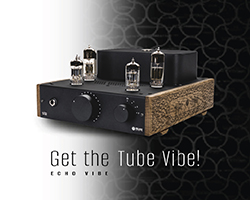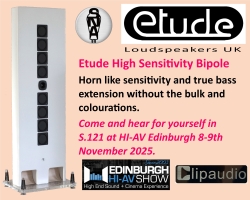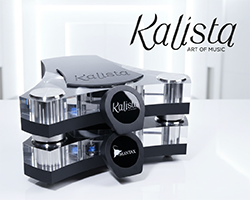AVID HIFI ACCENT INTEGRATED AMPLIFIER REVIEW
AVID HIFI’s Accent integrated amplifier is £4500 and represents the British brand’s entry-level amplifier, but it still boasts an onboard version of the Pellar phonostage and a headphone amplifier too. Janine Elliot takes a listen.
AVID HIFI has never done anything digital – indeed, it all started with vinyl – and I guess they never will, as AVID owner Conrad Mass suggested when he delivered to me the black entry-level integrated “Accent” amplifier coming in at a mere (in AVID terms) £4500. But don’t think this is a basic amplifier, it comes complete with the innards of the £950 Pellar phonostage built into the single PCB, plus a classy class A headphone amplifier. The design and components are trickled down from their more expensive amplifiers, maintaining some really excellent audio design and build quality. All the work is manufactured in-house, including the metal work. Indeed, this has become a very important part of AVID, the company producing metalwork for PMC professional speakers, military parts, products for motorsport racing teams, and in the past this included the Aston Martin DB9 and Vanquish.
AVID HIFI might not have hit the HiFi world until 1995, but the story goes back to 1977 when a friend of Conrad showed him his kit Connoisseur BD1 turntable, telling him that it was the bees-knees. Conrad was skeptical and began his adventure into creating what he believed would be the best turntable. He looked at every turntable design and realised that the real enemy was vibration. After exploration in universities to test his theories, and even working in a foundry to better understand casting, the Acutus turntable was born 2 decades later. In between all this Conrad worked for the Watford KJ Leisure HiFi Shop – where I spent many hours brooding over top-end HiFi that I simply couldn’t afford as a child – and then Musical Fidelity in the mid ‘80s. AVID (A Very Interesting Design) began in 1995 in a quarter of his garage in Flitwick, Bedfordshire, and then grew to 2/3rds of the garage (simply by moving the internal wall he had built!) After 4 years of hard work the turntable was first released to the public in 1999. AVID then moved to Kimbolton, near Huntingdon, Cambridgeshire. Initially a 15,000 square feet warehouse, it relocated to a 5k site in 2010 and added a further 5k building in 2017. Now the company produces everything from turntables, phono-stages, amps, speakers, arms, cartridges, cables and stands. Everything you need as long as it’s not digital!
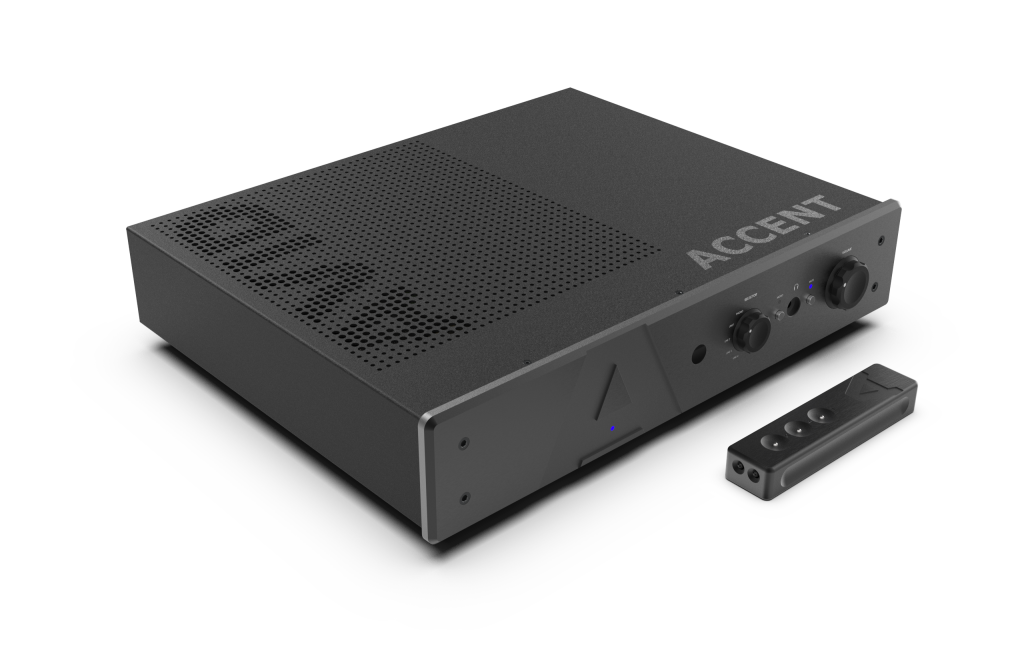
BUILD QUALITY AND FEATURES OF THE AVID ACCENT
This amplifier, available in silver or black, is an excellently built product and similar in looks to the larger £9300 Integra and top end £16000 Sigsum integrated amplifiers, with a large “A” machined on the 12mm faceplate. This feature can be seen on all AVID amplifiers. On the top left is the word “AVID”, made by having larger holes in the ventilation, as well as the word ‘Accent’ etched on the top right, just so you know what you’ve plugged in. The on-off toggle switch is under the front of the amplifier. There is no switch at the rear that you can’t reach (hurrah!) and no standby. It’s good to see the iconic AVID “knobs” are also a feature; the design originally appearing in the Pulsare phono-stage, being a scaled down version of the record clamp from the Vulvere turntable. These knobbly knobs are so easy to hold with your fingers and look great. The front is laid out similarly to the other integrated’s; a 5-position source knob (phono plus four line inputs) followed by mono button, 6.35mm headphone socket and mute button, and then the volume control, using the excellent Alps Blue Velvet RK27 fader, which also features in the Integra. Internally, the unit is a single PCB with a substantial 617VA toroidal power supply with 40,000uF electrical storage capacity, which is an awful lot for a class AB 70W/8Ω amplifier, though not as big as in the 90W Integra and significantly less than the amazing Reference Monoblocks at 600,000uF! More on the power supply later. Electronics include custom polypropylene capacitors. The excellent headphone facility is a separate class A amplifier, with plenty in reserve for weaker planars, and is the same that appears in the more expensive Integra and SigSum. The phono-stage is taken from AVID’s highly successful and excellent Pellar and can be switched between moving magnet and low and high moving coil via DIP switches at the rear. Whilst MM has standard 47kohm load, the MC load comes via external resistor RCA plugs pushed into separate “LOAD” sockets at the rear. While the Accent comes complete with a 500ohm plug, other values can be requested from the company. 500ohm works fine with most MC cartridges. The sockets are excellent, especially for the loudspeakers. To complete the purchase, the unit comes with a substantial remote control made from a single solid piece of aluminium and matching the amplifier in either black or silver. Even on very expensive HiFi these days I am often disappointed by still seeing cheap plastic remotes or poor lightweight metal ones. I remember when Cambridge Audio brought out their £350 Azur 350C CD player many years ago it instigated the appearance of good quality and heavy metal/plastic remotes on relatively cheap audio. The Accent remote is an excellent design, having a distinctive recessed shape that fits well into your hands when you are holding it. The remote has just three buttons; up, down, and mute. While selection of sources cannot be selected via the remote (it assumes you’d be putting a record on the turntable anyway, so you’d have already selected the source, so there’s no need for the remote function) the selector knob itself uses relays which are placed right at the back of the amplifier near the sockets and phono-stage to keep wiring runs short, meaning better sound quality and you will never have dirty contacts or degradation of sound as the audio signal does not go through the knob.
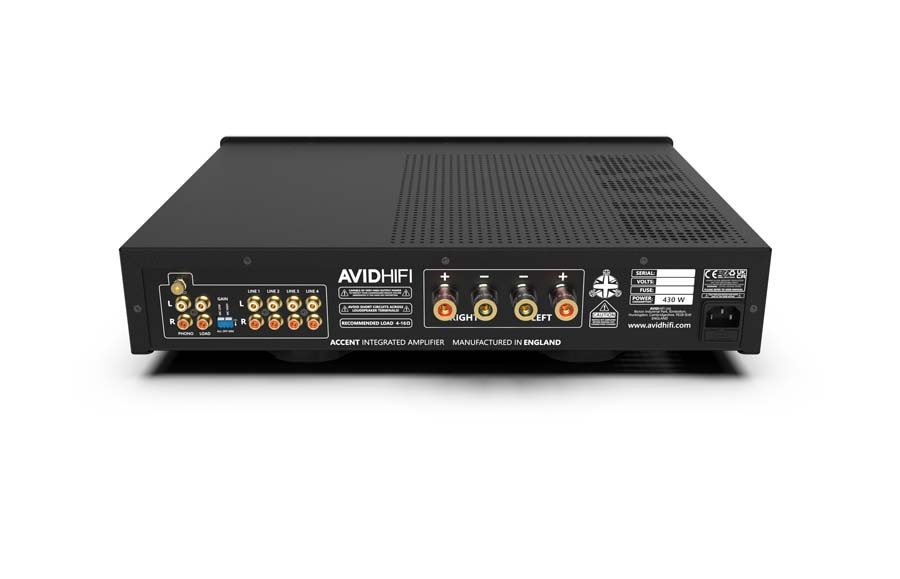
SOUND QUALITY
I played a great selection of music types and used both my Wilson Benesch Arcs and Graham LS5/9 speakers. Two products that sound so different from each other; the WB being highly critical and fast, and the latter being beautifully musical and a little more relaxed. I did think the Arcs wouldn’t work as it tends to be a bit shy in the bass, but through the Accent, that bass end – such as in the title track of Eagles ‘Long Road Out of Eden’ – was highly charged, particularly the power in the kick drum. This, I am assured, is due to the excellent power supply; having 617VA available and a 40,000uF reservoir ensured good quality audio could get to the speakers without suffering a change in sound quality or even cut-outs at low volume levels. As Conrad told me;
“At low levels, certain amplifiers may lose one channel, but our oversized power supply ensures that both channels remain audible even at vanishing low listening levels.”

Many amps can sound bass-light at low levels, but the Accent performed brilliantly at all levels (I remember finding this in the then entry-level integrated Integra that I reviewed a few years ago). Having enough horsepower to drive the Wilson Benesch also enabled an excellent slew rate so that initial transients from the Eagles LP were extremely fast. Similarly, both the amplifier and phono-stage are exceptionally quiet due to the power supply and large grounding plane.

“Our extensive filtering capacitors and grounding planes contribute to an exceptionally low noise floor, enabling you to discern micro details that might otherwise be blurred or completely obscured.” Says Conrad.
Miles Davis ‘Bitches Brew’ was very tight and open, with great clarity to hear every detail of the trumpet and saxophone. Through the Graham Audio LS5/9 the music was not only fast, but also amazingly musical; the trumpet sounding as realistic as I have ever heard through speakers. The Fender Rhodes keyboard from Chick Corea’s fingers was tight and secure. “Miles Runs the Voodoo Down” had excellent spread and 3D soundstage, plus bass extension without any fuss.
‘Vivaldi in Venice’ from Chasing the Dragon is a brilliantly engineered and sounding double album that sounded great through both makes of speakers. Indeed, an amplifier should work well on any speaker system if it is designed well. There was excellent control and detail with powerful bass, especially on the cello “thumps”. This 70 watt amp never felt short of oomph! A detailed soundstage and a capture of the essence of the music were particularly enjoyed in Vivaldi’s “La Follia” Trio Sonata RV63. The harpsichord was detailed (especially with the Wilson Benesch) and perfectly positioned. Page turns on this live performance were crisp and audible, showing this AVID never let anything be hidden from the listener. This is a very quiet phono-stage that excels in its musicality. Those wanting a relatively cheap integrated for vinyl playback could look no further than the Accent to meet their needs. Classical music sounded particularly good here, and indeed the AVID played all types of music equally well.


Turning to the 1980 rock album from Rush, recorded at the Kiel Auditorium in St Louis MO just after releasing their ‘Permanent Waves’ album, the Canadian band performed with great vigor which came across with great ease from the Accord. 70 watts worked surprisingly well, even heavy rock music at higher listening levels. This 2015 heavyweight remix album has plenty of distorted guitars, bashed drums, analogue synths and effects. The cymbals were excellent, on both WB and Graham speakers, especially with the addition of the Townshend Supertweeter. The AVID allowed the instruments to be very tidy, plus the audience atmosphere added to form a very realistic performance. If I had any criticism of the amplifier it would be that it could be a little too controlled, though its accuracy made for a very engrossed listening from your truly, rather than me putting on the music and then me wondering what the weather will be like tomorrow. I really did concentrate on the music, and long listening sessions were never fatiguing. Even on headphones the music was highly accurate and musical. This headphone amp isn’t just an add-on, this is a properly designed affair from the more expensive Integra and Sigsum, and I found it worked as well as most of my stand-alone headphone amplifiers. Driving headphones between 20-600Ω, my inefficient Sennheiser HD650’s sounded detailed and controlled, even in the bass end, which can often sound weak on these cans.
On digital and reel-to-reel sources, the music was equally compelling and fast. ‘Old Betsy’ is a well-engineered reel-to-reel of tenor saxophonist Ben Webster and here the performance was very detailed and highly musical; even the often hoarse-sounding saxophone with streams of breaths as he blew into the instrument never sounded out of place. With numbers from Ellington, Berlin, Rodgers, and others, this was a captivating performance that sounded much better than I expected from a £4500 entry-level integrated.
CONCLUSION
The Accent is by no means a watered-down member of the AVID HIFI family. This was designed from the ground up to be a big performer – and perform it did, with excellent speed and control. With an excellently designed power supply, the sound was full and fast at all levels and on any loudspeaker, offering great bass-end on even my bass-light Wilson Benesch Arcs. Build quality, as in all AVID HIFI products, was outstanding. I have followed the company for many years, even listening to the top-end Reference preamp and mono-blocks which total £170,000, and so the Accent would be the perfect and relatively painless £4500 introduction to the company if you want to explore their musical ethos.
AT A GLANCE
Build Quality:
This is an excellent tank-like built product
Sound Quality:
Well-extended bass and pin-sharp top end
A very quiet phono-stage
Value For Money:
£4500 gets you well and truly into what AVID HIFI is all about, and at that price, worth every penny
We Loved:
Bass extension
Transients
Pellar phono-stage
Tank-like construction
We Didn’t Love So Much:
If you do need to alter the phono-stage settings, it might be fiddly without removing the amp
Elevator Pitch Review: AVID HIFI is a very trusty British manufacturer of anything analogue, whose top-end amplification system is not far short of £200,000. So, to be given their entry-level £4500 integrated to play with made me wonder just what might be lacking. But this turned out to be a big surprise to me.
Janine Elliot
Pre-Audio GL-1102N/Audio Technica AT33sa (turntable/cartridge); Nagra iv SJ (reel to reel); ifi/A&K (digits); Esprit, Ecosse and Townshend cables, Coppice Audio stand and Townshend rack.
SPECIFICATIONS
POWER OUTPUT:
70W 8Ω
HARMONIC DISTORTION:
0.03% (80% POWER 8Ω 1KHz)
LOUDSPEAKER IMPEDANCE:
4-16Ω
PHONO INPUTS:
1x RCA 1x LOADING
GAIN:
48dB – 60dB – 70dB
INPUT RESISTANCE:
47K – CUSTOM (500Ω LOADING PLUGS SUPPLIED)
INPUT CAPACITANCE:
100pF
LINE INPUTS:
4x RCA LINE INPUTS
HEADPHONE OUTPUT:
9 V RMS
HEADPHONE RANGE:
20 — 600Ω
INPUT VOLTAGE:
115V OR 230V AC
DIMENSIONS:
470 x 410 x 110mm (WxDxH)
NET WEIGHT:
14.5KG (32Lb)





















































































